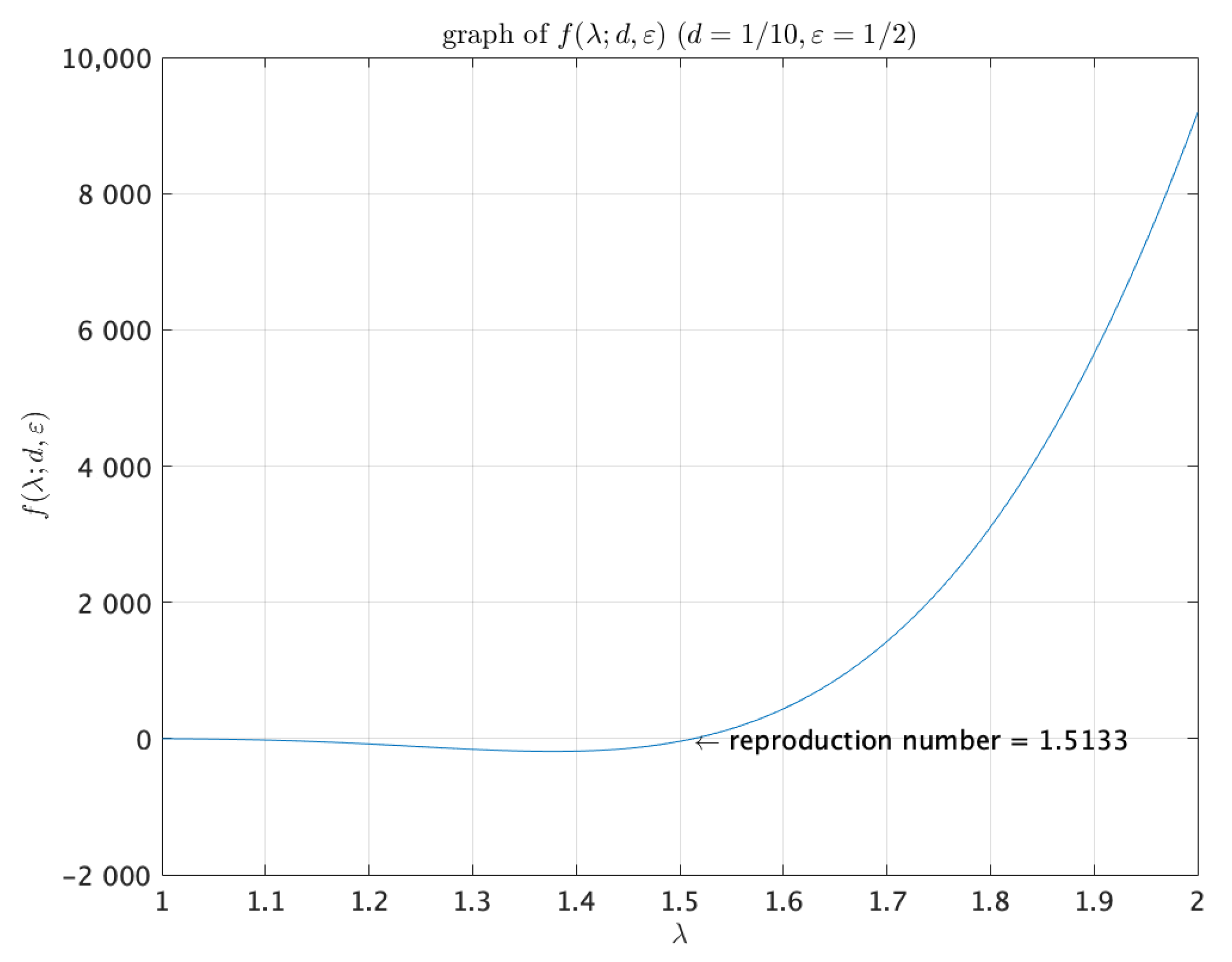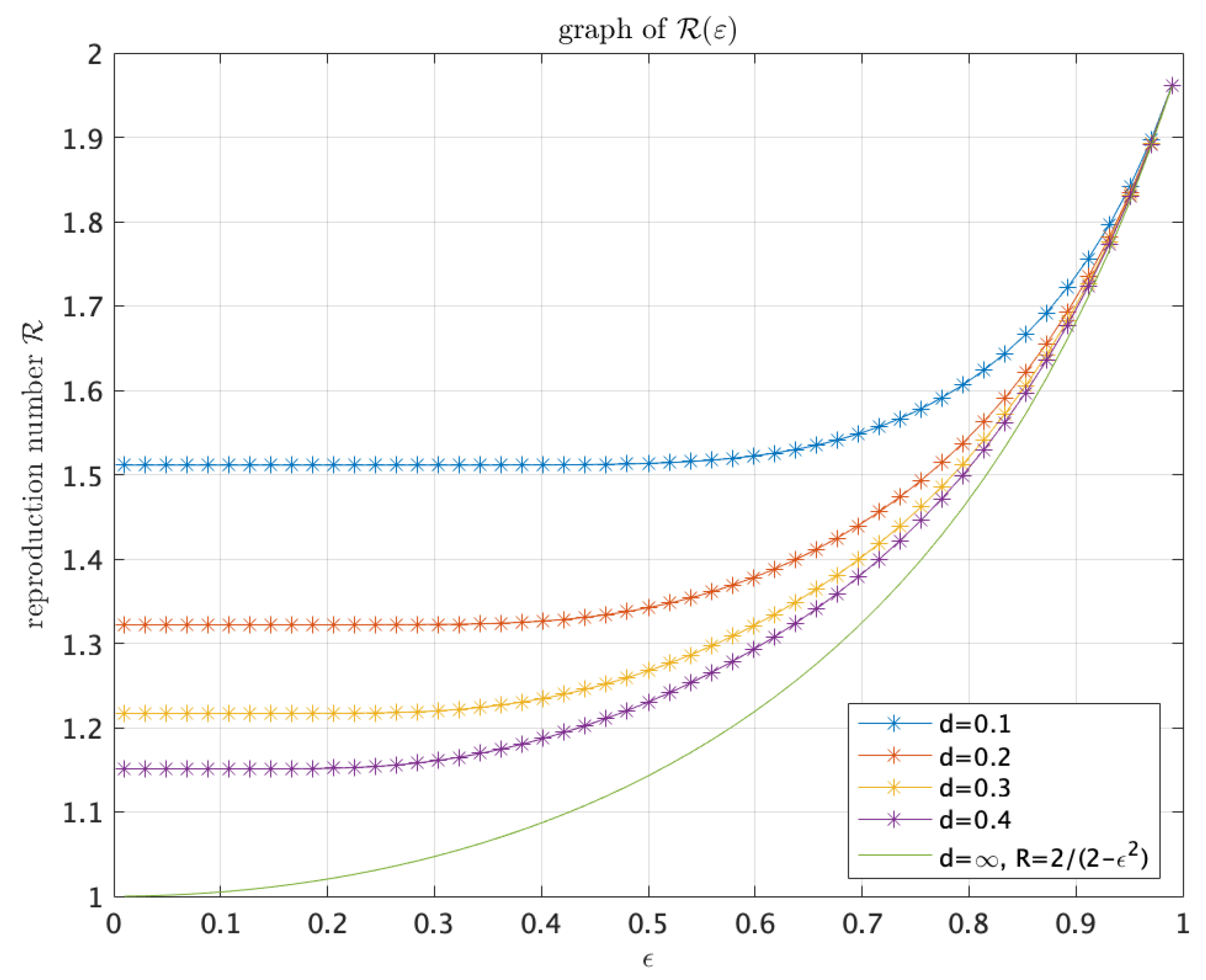Impact of Regional Difference in Recovery Rate on the Total Population of Infected for a Diffusive SIS Model
Abstract
1. Introduction
2. Known Results
2.1. Diffusive SIS Model
2.2. Diffusive Logistic Equation
3. Main Results and Proofs
3.1. Profiles of the Infected Population Density
3.2. Analysis of the Reproduction Number
3.3. Numerical Simulation for the Reproduction Number
4. Discussion
Author Contributions
Funding
Conflicts of Interest
References
- Allen, L.J.S.; Bolker, B.M.; Lou, Y.; Nevai, A.L. Asymptotic profiles of the steady states for an SIS epidemic reaction-diffusion model. Discret. Contin. Dyn. Syst. Ser. A 2008, 21, 1–20. [Google Scholar] [CrossRef]
- Ladyženskaja, O.A.; Solonnikov, V.A.; Ural’ceva, N.N. Linear and Quasi-Linear Equations of Parabolic Type; Translations of Mathematical Monographs, 23; ; American Mathematical Society: Providence, RI, USA, 1968. [Google Scholar]
- Peng, R. Asymptotic profiles of the positive steady state for an SIS epidemic reaction-diffusion model. I. J. Differ. Equ. 2009, 247, 1096–1119. [Google Scholar] [CrossRef]
- Peng, R.; Yi, F. Asymptotic profiles of the positive steady state for an SIS epidemic reaction-diffusion model: Effects of epidemic risk and population movement. Physica D 2013, 259, 8–25. [Google Scholar] [CrossRef]
- Wu, Y.; Zou, X. Asymptotic profiles of steady states for a diffusive SIS epidemic model with mass action infection mechanism. J. Differ. Equ. 2016, 261, 4424–4447. [Google Scholar] [CrossRef]
- Allen, L.J.S.; Bolker, B.M.; Lou, Y.; Nevai, A.L. Asymptotic profiles of the steady states for an SIS epidemic disease patch model. SIAM J. Appl. Math. 2007, 67, 1283–1309. [Google Scholar] [CrossRef]
- Cui, J.; Tao, X.; Zhu, H. An SIS infection model incorporating media coverage. Rocky Mount. J. Math. 2008, 38, 1323–1334. [Google Scholar] [CrossRef]
- Cui, R.; Lam, K.-Y.; Lou, Y. Dynamics and asymptotic profiles of steady states of an epidemic model in advective environments. J. Differ. Equ. 2017, 263, 2343–2373. [Google Scholar] [CrossRef]
- Cui, R.; Lou, Y. A spatial SIS model in advective heterogeneous environments. J. Differ. Equ. 2016, 261, 3305–3343. [Google Scholar] [CrossRef]
- Deng, K.; Wu, Y. Dynamics of a suscetible-infected-susceptible epidemic reaction-diffusion model. Proc. Roy. Soc. Edinb. Sect. A 2013, 146, 929–946. [Google Scholar] [CrossRef]
- Ding, W.; Huang, W.; Kansakar, S. Traveling wave solutions for a diffusive SIS epidemic model. Discret. Contin. Din. Syst. Ser. B 2013, 18, 1291–1304. [Google Scholar] [CrossRef]
- Gao, D.; Ruan, S. An SIS patich model with variable transmission coefficients. Math. Biosci. 2011, 232, 110–115. [Google Scholar] [CrossRef]
- Ge, J.; Kim, K.I.; Lin, Z.; Zhu, H. A SIS reaction-diffusion-advection model in a low-risk and high-risk domain. J. Differ. Equ. 2015, 259, 5486–5509. [Google Scholar] [CrossRef]
- Huang, W.; Han, M.; Liu, K. Dynamics of an SIS reaction-diffusion epidemic model for disease transmission. Math. Biosci. Eng. 2010, 7, 51–66. [Google Scholar]
- Kuto, K.; Matsuzawa, H.; Peng, R. Concentration profile of endemic equilibrium of a reaction-diffusion-advection SIS epidemic model. Calc. Var. Partial Differ. Equ. 2017, 56, 1–28. [Google Scholar] [CrossRef]
- Li, H.; Peng, R.; Wang, F.-B. Varying total population enhances disease persistence: Qualitative analysis on a diffusive SIS epidemic model. J. Differ. Equ. 2017, 262, 885–913. [Google Scholar] [CrossRef]
- Li, H.; Peng, R.; Xiang, T. Dynamics and asymptotic profiles of endemic equilibrium for two frequency-dependent SIS epidemic models with cross-diffusion. Eur. J. Appl. Math. 2020, 31, 26–56. [Google Scholar] [CrossRef]
- Peng, R.; Zhao, X.Q. A reaction-diffusion SIS epidemic model in a time-periodic environment. Nonlinearity 2012, 25, 1451–1471. [Google Scholar] [CrossRef]
- Peng, R.; Liu, S.Q. Global stability of the steady states of an SIS epidemic reaction-diffusion model. Nonlinear Anal. TMA 2009, 71, 239–247. [Google Scholar] [CrossRef]
- Inoue, J.; Kuto, K. On the unboundedness of the ratio of species and resources for the diffusive logistic equation. Discrete Contin. Dyn. Syst. Ser. B 2021, 26, 2441–2450. [Google Scholar] [CrossRef]
- Cantrell, R.S.; Cosner, C. Diffusive logistic equations with indefinite weights: Population models in disrupted environments. Proc. Roy. Soc. Edinb. Sect. A 1989, 112, 293–318. [Google Scholar] [CrossRef]
- Lou, Y. On the effects of migration and spatial heterogeneity on single and multiple species. J. Differ. Equ. 2006, 223, 400–426. [Google Scholar] [CrossRef]
- Lam, K.-L.; Lou, Y. Persistence, Competition and Evolution. In The Dynamics of Biological Systems; Bianchi, A., Hillen, T., Lewis, M., Yi, Y., Eds.; Springer: Berlin/Heidelberg, Germany, 2019; pp. 205–238. [Google Scholar]
- Lam, K.-L.; Liu, S.; Lou, Y. Selected topics on reaction-diffusion-advection models from spatial ecology. Math. Appl. Sci. Eng. 2020, 1, 150–180. [Google Scholar] [CrossRef]
- Bai, X.; He, X.; Li, F. An optimization problem and its application in population dynamics. Proc. Amer. Math. Soc. 2016, 144, 2161–2170. [Google Scholar] [CrossRef]


Publisher’s Note: MDPI stays neutral with regard to jurisdictional claims in published maps and institutional affiliations. |
© 2021 by the authors. Licensee MDPI, Basel, Switzerland. This article is an open access article distributed under the terms and conditions of the Creative Commons Attribution (CC BY) license (https://creativecommons.org/licenses/by/4.0/).
Share and Cite
Inoue, J.; Kuto, K. Impact of Regional Difference in Recovery Rate on the Total Population of Infected for a Diffusive SIS Model. Mathematics 2021, 9, 888. https://doi.org/10.3390/math9080888
Inoue J, Kuto K. Impact of Regional Difference in Recovery Rate on the Total Population of Infected for a Diffusive SIS Model. Mathematics. 2021; 9(8):888. https://doi.org/10.3390/math9080888
Chicago/Turabian StyleInoue, Jumpei, and Kousuke Kuto. 2021. "Impact of Regional Difference in Recovery Rate on the Total Population of Infected for a Diffusive SIS Model" Mathematics 9, no. 8: 888. https://doi.org/10.3390/math9080888
APA StyleInoue, J., & Kuto, K. (2021). Impact of Regional Difference in Recovery Rate on the Total Population of Infected for a Diffusive SIS Model. Mathematics, 9(8), 888. https://doi.org/10.3390/math9080888






